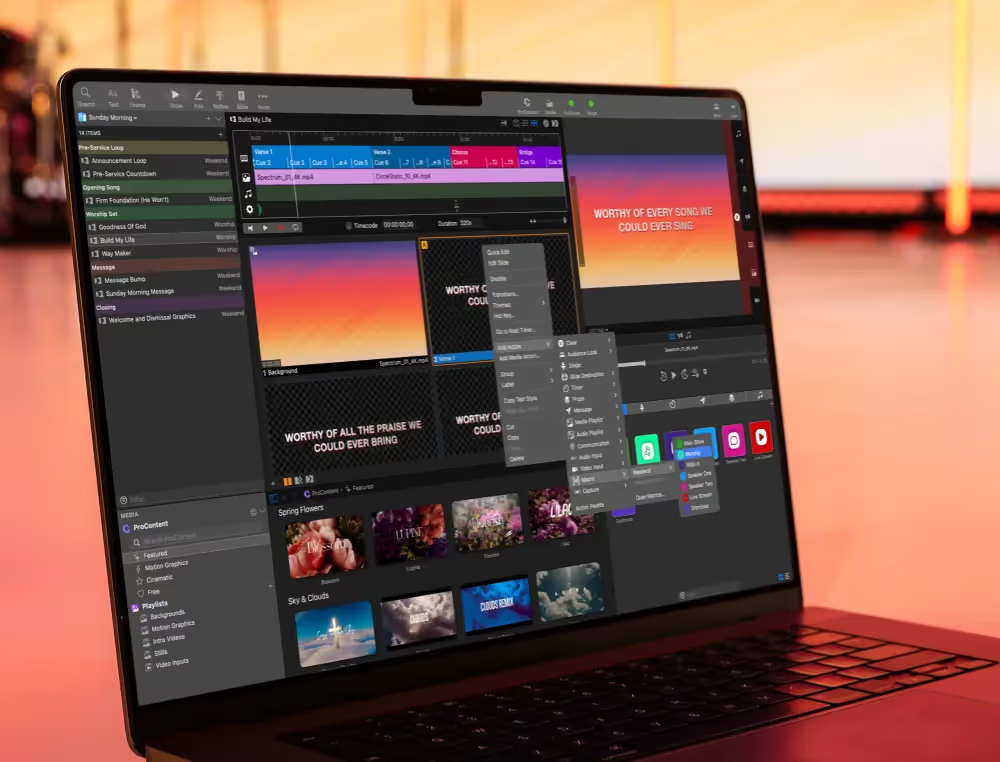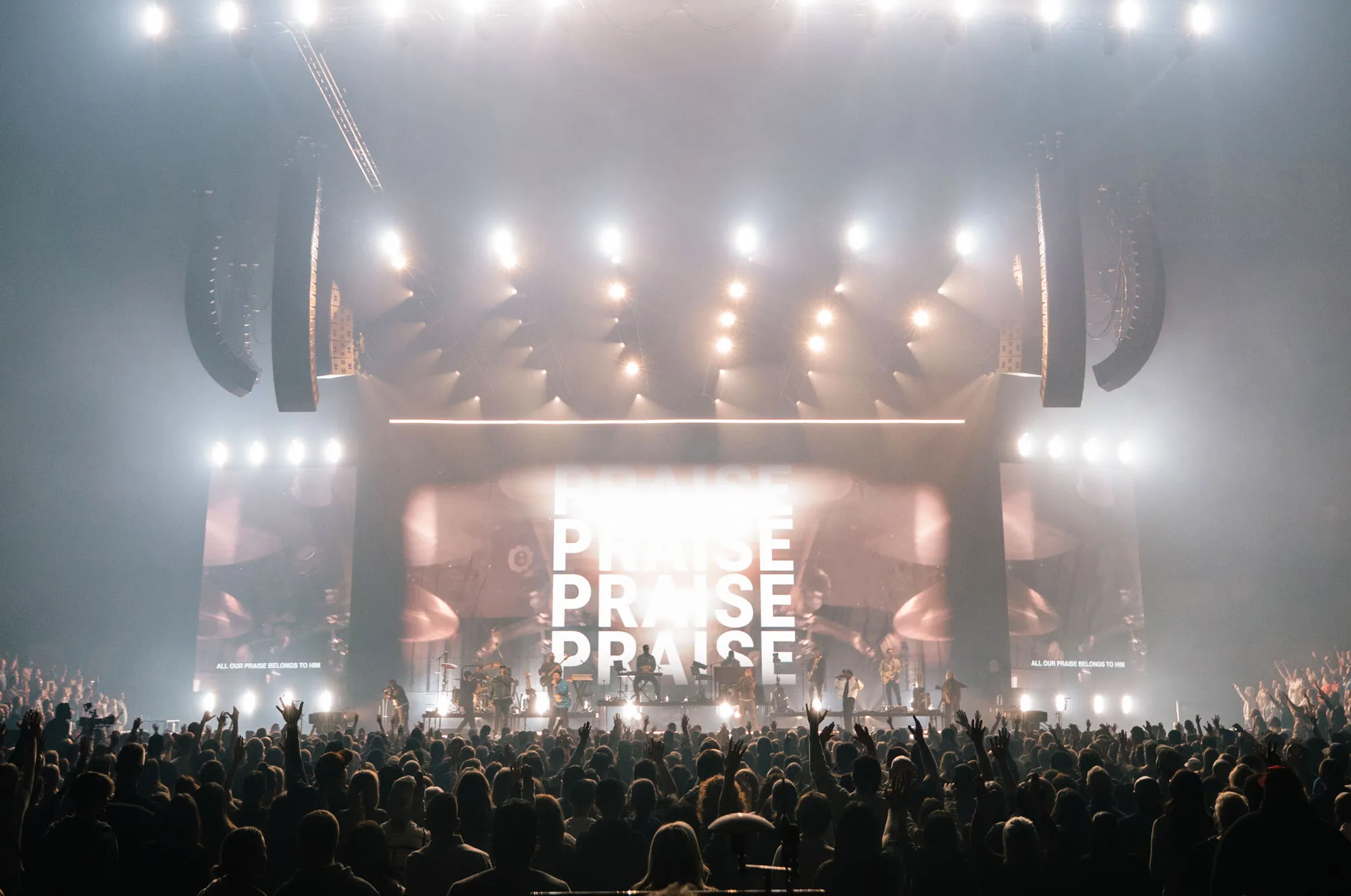Learn more Introducing the ProPresenter Lyric Banner!
December 19, 2014, 5:15 pm

Most of our House of Worship (HOW) articles are about sanctuaries, per se. However, this month’s focus is on a separate AV space within a religious center. Thus, the John C. Maxwell Leadership Center (max wellcenter.com) at 12Stone Church (12stone.com) in Atlanta GA honors the life and impact of Maxwell’s global and generational leadership as an internationally recognized speaker, author and pastor. In celebration of his continuing legacy, visitors today enjoy interactive audiovisual presentations of Maxwell’s life and achievements across an immersive videowall controllable from several user stations.
We’ll explore the AV after a backgrounder on the center. It’s the headquarters for EQUIP (maxwell center.com/partner/equip), a nonprofit organization founded by John and Larry Maxwell that has trained six million Christian leaders in more than 185 countries. They are committed to mobilizing transformational leaders in every nation around the world through live conferences, biblically centered resources, technology and partnerships. Leaders respond to nations in crisis, impact nations in progress and add value to nations with major social issues.
12Stone’s initiatives include leadership training and coaching, a two-year residency program and biblical education courses in partnership with churches, Indiana Wesleyan University and The Wesleyan Church.
AV project credits go to several greater Atlanta-area firms. Retro 8 Films (retro8films.com) worked directly with the center’s namesake John C. Maxwell. Under the guidance of Retro 8 Owner Ryan Shove, the film company scripted and shot the screen content in 4K resolution. Our interviews feature Sam Tesh, CEO/Owner, Civil Creative Agency ([email protected]), which custom-designed and built out the space. Then Brian Morrison, Director of AV Integration, Velocity Productions (velocityproductions.com), details the company’s AV design and installation. For further clarification, Civil Creative Agency built everything around the videowall, while Velocity did the actual videowall installation and all the mechanics.
The major design challenge of Civil Creative was building out the videowall onto a curved wall. Screen components consist of multiple Barco NSL-4621, 46-inch LCDs in a four-wide by three-tall configuration.
According to Tesh, his company was hired directly by the client. “The design is really the magic, which honors John Maxwell and his legacy. We wanted to create a place that served several functions. It had a great flow of traffic and was highly engaging. It also served as a good meeting space. That’s where Velocity came in with their ability to execute the design on a high level on the AV side. They did great work on the screens.”
He noted that he worked with Maxwell directly, as well as the center’s President David Hoyt and Executive Assistant Linda Edgars. “We were on a very compressed timeline in a brand new building,” said Tesh. “Everyone really pulled together to have this project ready and done with excellence by the opening of the building. This is a great place to have events.”
Tesh pointed out the design challenges encountered in creating flow and an immersive environment in the space. Thus, Civil Creative took a basically square room and created an inner circle within it. “That encourages people to follow the seamless pattern flow. It was great from a design standpoint. But it was quite difficult to execute on a build level. Rectangular screens had to fit together in such a way to create a circular pattern. The space was all 3D-modeled with notes and material choices.” Design software included SketchUp, Revit, AutoCAD and Adobe Photoshop.
Tesh explained that the screen setup was custom made in their shop in Atlanta, and the pieces were then brought in and seamed together. Care was taken to make sure that there is proper ventilation for the monitors. The work included the globe that hangs down, and the header above it. The continents on the globe are comprised of pages from Maxwell’s books wherein the language of each continent is represented. For example, there’s Mandarin for China and Portuguese for Brazil. In so doing, that reflects the global impact of the author’s writings.
“There’s a great seating area in the middle of the space,” said Tesh. “It’s all interactive with iPads where you can learn about Maxwell’s books and his legacy. We’ve really strived for versatility. We don’t want this space to ever feel old or like, ‘Oh, I’ve already seen it.’ So, the best way to do that is to have an easy way to change out content with the technology that allowed us to do that.” Specifics about screen content will be discussed later.
Tesh pointed out, “From a practical level, we’re going to be continually adding to the space and putting in more bells and whistles as we go along. We did the videowall space as a sort of ‘hero’ area. We also designed and custom made the center’s boardroom and the library.”
It was the task of Velocity Productions to select the components and integrate the AV. “When you have a curved wall with monitors that are two to three inches deep,” said Brian Morrison, “you then have to add a bracket to the back. You have to be conscious about the rate of the curve and building a structure on the back side that will support it. And then you have to be able to get in there to do service. You have to keep that all in mind.”
He noted that Barco screens for the videowall were chosen for several reasons. “The picture quality is incredible, right out of the box.” The videowall looks seamless to the viewer because the individual screens, “bezel to bezel, have the smallest width from pixel to pixel.”
Scaling and processing were other reasons. “When you’re looking at the image, you can’t tell that it is a 1920×1080 image stretched across the monitors. The colors look deep and rich, and there is hardly any pixilation at all. Even with fast-moving videos, everything looks great. We knew it would be costly to try to send each monitor its own 1920×1080 image.”
A high level of customer support was another major reason for choosing Barco, as well as the Renewed Vision’s ProVideoPlayer 2 (PVP2) that supplies screen content for the videowall.
Other reasons for choosing the PVP2 include its affordability and straightforward operation, according to Morrison. “The layouts are appealing, and the playlists are easy to create and manage. The player is enabling the center to achieve some interesting applications.” The player’s software resides on a Mac Pro delivering two DisplayPort signals to a DVI adaptor to transport signals to the videowall. With the wall arranged in a 4×3 configuration, Velocity programmed the PVP2 software to split the wall into two 2×3 sections, sending a 1920×1080 image to each section. The video monitors then break up the video signal across all monitors in each 2×3 section.
Visitors can control volume and access content via a Savant Systems six-button controller next to the videowall. In addition, Velocity used a custom Savant iOS app to drive videowall content from tablets across the various user stations in the room. The PVP2 integrates with the Savant over ArtNET via the DMX protocol to add a second interactive element to the experience. Thus, the end user can scroll through and call up any of eight educational videos produced for the Maxwell Center via an iPad, iPhone or Apple laptop. The eight videos otherwise rotate across the videowall on a continuous basis. They show specific times in John C. Maxwell’s life.
Bamboo Creative custom built an iPad app, which provides an interactive museum experience search for behind-the-scenes content in the center, such as passages from Maxwell’s books or videos about his leadership training. Access is via an Apple Mac mini server. There are iPads for participants in the seating circle and to the left and right of the videowall. They listen on Shure SHR240 headphones.
Morrison pointed out that another Mac mini web server allows content to be updated. “We can dynamically update the content,” explained Morrison. “If there are any new videos or books the center wants to add, we can do that.” There’s yet another Mac mini, called an admin computer, where Velocity can remotely drop in files without disturbing the other apps. And, there’s a backup if the web server goes down, where Velocity can redirect the IP address and the videowall system is back up and running.
A cloud-based Cisco Meraki MR18 system is used for WiFi and security purposes. Morrison gave some examples of monitoring. “Even if someone has the access code to get into the center’s system, we still have to give permission to get on. It also allows us to monitor network traffic. The iPads in the videowall space have custom apps that we can control. The Meraki can let us know how much battery life is left in those devices. If someone figures out how to get around an app and get on the internet, we can see what’s going on from here at Velocity.”
On the audio side, a Pioneer VSX-70 receiver/amplifier drives Boston Acoustics HSi 485 in-wall speakers. “It just needed to be simple for the client,” emphasized Morrison. “They wanted something that had good intelligibility and was easy to use. It also fits in well from an automation standpoint. Someone can control the volume easily, remotely. And if something goes totally crazy, you can easily tell someone on the phone to go over and turn that big knob down. ‘OK! I got it,’ they’d reply.”
Taking a wide view of the AV, he declared, “Technology is just a means to an end. We ask ourselves, ‘Who is our client?’ ‘How do they work?’ In the case of the center, they don’t have a dedicated IT person to hand the AV system off to. It had to be very simple and easy. And that’s how we selected the products for this application.”
Summing up the videowall viewing experience, Morrison said, “The curved space gives a more immersive feeling. When I walk in, I sit right in the middle of the seating area. I can see the entire videowall with my peripheral vision. However, because of the size of the room, so many people stand almost at the entrance. But in the seating area, I’ve seen groups of 10 to 12 people sitting and watching videos. It’s really great.”
By subscribing, you agree to our Terms and Conditions.
Experience the power of ProPresenter
Take your production to the next level with ProPresenter's intuitive suite of tools.

Stay Updated with Our Newsletter
Get the latest news, updates, and exclusive offers delivered straight to your inbox.

Questions?
Browse our FAQs or our Knowledge base that we’ve made to answer your questions. Need additional help? Connect with a support team agent!


.png)
.avif)